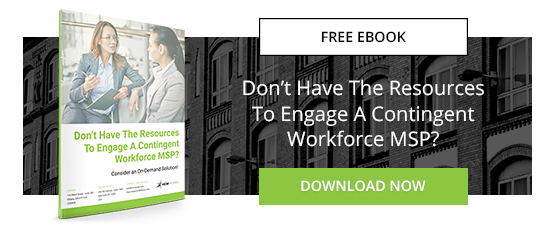There has been a steady upswing in the use of contingent labor in the United States. With an uncertain economy, businesses are looking for ways to continue to meet their customers’ demands and achieve their business goals while reducing their overhead. With labor being one the biggest expenses in business, it’s natural that many companies have been using contingent workers in order to transform their payroll expenses from a fixed cost to a variable cost.
The Benefits
With contingent workers, business owners do not have to pay a salary, holiday, overtime, vacation or sick pay, health coverage, or even contribute to taxes, unemployment insurance or social security. Moving to a flexible, on-demand workforce can significantly reduce a company’s labor costs. As these workers are typically paid through accounts payable rather than through typical payroll, companies can stretch their payroll budgets even further. Plus, because they are temporary workers without a commitment for ongoing work, business owners can scale their workforces up or down depending on budget. These are highly desirable features.
However fundamental contingent labor is becoming to the modern business model, it does have larger implications when it comes to payroll-specific issues, such as legal compliance, rates, and budgeting. Contingent payroll management can be complex, confusing, and risky.
Here are three things you need to know about contingent payroll management in order to better manage your temporary workforce.
Legal Compliance
The greatest contingent payroll management risk is legal compliance, and in particular, worker misclassification. Many temporary workers land in a gray area between employee and independent contractor. It’s extremely important for you to assess each and every contingent worker you bring on board to determine whether or not they are true contractors or if they would be considered employees by the IRS and other government bodies. If you fail to classify properly, you could face an audit, lawsuit, fines, penalties, and interest fees for all of the back taxes and other premiums and benefits that you should have been providing the worker all along. Using the economics realities test and various other tests can be of help during your worker assessments, though they are not foolproof.
Rates
It can be tricky to navigate compensation for independent contractors. As contingent labor is temporary by nature, many companies tend to sidestep their regular staffing policies when hiring and paying their contractors. This can lead to inconsistencies in pay rates. Companies want to negotiate an equitable and fair price for the labor, and depending on the type of work being performed and the agency being used, this can lead to very different pay rates.
Often, you could be paying your contingent workers unfair amounts compared to the salaries provided to your employees who are performing similar work. This can have an impact on employee morale, performance, and loyalty.
And as contingent payroll management is usually done through accounts payable, it can be difficult and time consuming to keep track of all the different rates being offered. It can be easy to make errors when paying workers, especially when you have dozens or hundreds of contingent workers on staff.
Head Count
Knowing how many workers are in your workforce is important for being able to have a true overview of payroll costs. But this can be especially difficult with contingent workers. Though many might be hired through an agency and you can get a head count by asking your agency representative, others will be hired directly by hiring managers. When hiring isn’t taking place solely through HR, payments aren’t being handled through your centralized payroll system, and contractors are being sourced by many different managers, it can be easy to lose track. An internal audit might be necessary to get true payroll costs.
Managing these contingent payroll management issues, and many others, can be difficult to do in-house. To streamline the process, consider using external contingent payroll management solutions.



